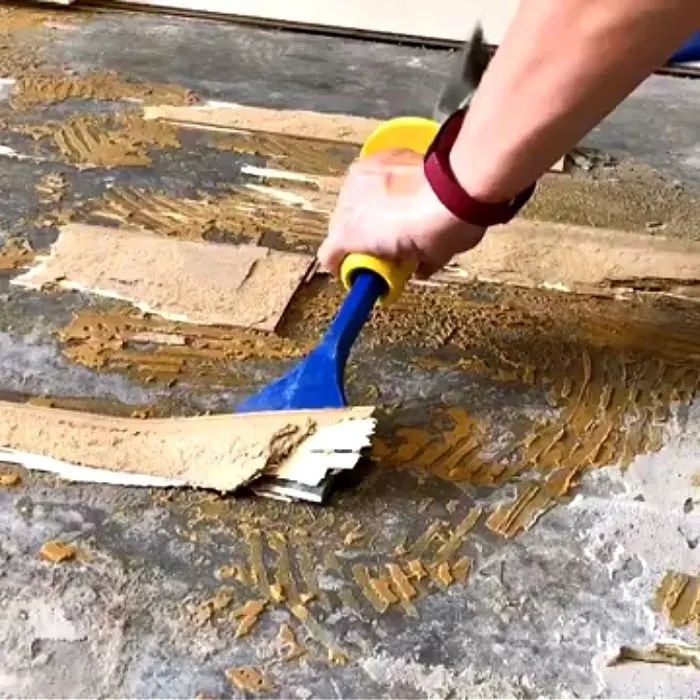Have you ever dropped a bottle of glue on your beautiful wood floor? Or maybe you tried a DIY project that went awry, leaving a sticky mess? It can be a real heart-stopping moment, watching the glue seep into the wood, fearing the worst. Thankfully, you’re not alone! Many people have encountered this predicament, and the good news is, with the right approach, you can save your wood floor from the perils of glue.

Image: mromavolley.com
This guide will take you through a comprehensive journey to tackle glue stains on your wood floor, providing you with the knowledge and techniques to restore its pristine beauty. We’ll cover various types of glue, effective cleaning methods, and tips from experts to ensure successful removal and minimal damage to your flooring. Get ready to equip yourself with the knowledge and confidence to overcome this sticky situation!
Understanding the Glue Enemy
The first step to a successful battle is knowing your enemy! Different types of glue require different approaches. Be sure to identify the type of glue you’re dealing with, as this will guide your cleaning strategy:
1. Water-based Glue: These are often the most common culprits, found in school projects, crafts, and some wood glues. They are generally easier to remove than their solvent-based counterparts.
2. Solvent-based Glue: These glues are stronger and often used for heavier-duty tasks. They can be trickier to remove and might require more aggressive cleaning methods.
3. Epoxy Glue: This strong adhesive is known for its durability and often used in projects that require a permanent bond. It can be incredibly difficult to remove and may necessitate professional assistance.
Tackling the Sticky Situation: The Right Tools and Techniques
Now that we understand the different types of glue, let’s dive into the practical aspect of removing them from your wood floor. Remember, every situation is unique, so be patient and try different methods if the first one doesn’t work.
1. Patience is Key: Don’t rush the process! For most glue types, the longer the glue sits, the more difficult it becomes to remove. Immediate action is ideal, but even if time has passed, don’t despair. We’ll equip you with the best strategies to combat seasoned glue stains.
2. The Power of Preparation:
- Scrape It Off: Gently scrape off any excess glue with a plastic scraper or a dull knife. Be careful not to scratch the wood.
- Protect Yourself: Wear gloves to avoid any skin irritation or allergies.
- Ventilate the Area: Ensure proper ventilation, especially when using chemicals.
3. Gentle Cleaning Methods:
- Warm Water and Soap: For water-based glues, try using warm water and a mild dish soap. Gently rub the affected area and allow it to soak for a few minutes before wiping clean.
- Vinegar: The acidity of vinegar can sometimes break down glue bonds. Dampen a cloth with white vinegar and apply it to the sticky area. Let it sit for a few minutes, then scrub gently. Rinse with water and dry thoroughly.
4. For Stubborn Glue:
- Acetone or Nail Polish Remover: For solvent-based glues, acetone or nail polish remover can be effective, but use it with caution! Test it on an inconspicuous area first to ensure it doesn’t damage the finish. Apply it sparingly to a cloth and gently rub the glue stain.
- Mineral Spirits: This solvent is effective on many types of glue but can be harsh on some finishes. Test it on an inconspicuous area first. Apply it with a cloth and gently rub the stain.
- Heat: A hairdryer can sometimes soften the glue, making it easier to remove. Apply heat to the glue, being careful not to overheat the wood. Use a scraper to lift off the softened glue.
5. Deep Cleaning and Refinishing:
- Sanding: If the glue has seeped into the wood, you may need to sand the area to remove it. Use fine-grit sandpaper and work carefully.
- Refinishing: After removing the glue, consider refinishing the affected area to match the rest of the floor. Consult a professional if you’re unsure about the process.
Expert Tips and Insights
1. Prevention is Key: To prevent glue disasters in the future, consider these expert tips:
- Use a Drop Cloth: Always use a drop cloth or plastic sheeting to protect your floors during DIY projects.
- Clean Up Spills Immediately: The earlier you address spills, the easier they are to clean.
2. Seek Professional Help: For epoxy glue, stubborn stains, or extensive damage, it’s best to consult a professional flooring specialist. They have the knowledge and tools to safely and effectively remove glue and restore your floor to its original beauty.

Image: mromavolley.com
Best Way To Get Glue Off Wood Floor
Conclusion
Armed with this guide, overcoming a glue mishap on your wood floor is no longer a daunting task. Remember, patience, proper cleaning techniques, and the right tools are your secret weapons. By understanding the glue, approaching the cleaning process with care, and potentially seeking expert assistance when needed, you can reclaim your pristine wooden surfaces. Don’t let a sticky situation ruin your day – now you have the know-how to conquer it! Share your experiences in the comments below and let others learn from your journey. Happy cleaning!






